Identifying Leather
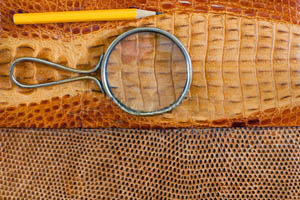
It is important to know the specifics about the material you're buying in order to better maintain its longevity. There are many different types of leather available, each with its own unique look and feel, but using this simple chart you can easily differentiate between various types.
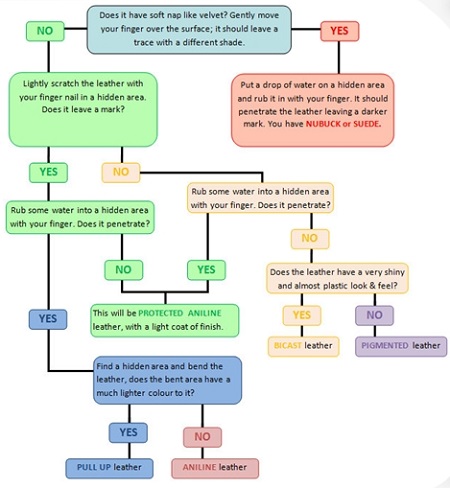
In order to properly determine a type of leather there are a few tests that we can do.
- Magnifying Glass Test: Looking at leather under a magnifying glass will show us in detail the finish applied to the leather, or if there is a finish on the leather.
- Water Absorption Test: This test helps us identify how easy your leather will be to clean, and how effective the finish on it is.
- Visual Test: Looking at leather tells a lot, are there any natural markings visible? What colour is it? etc
- Touch Test: Feeling the leather for softness, smoothness, grain pattern also helps identify the leathers type.
To make things a little easier for you, we can break down the different types of leather into categories, each containing a group of leathers with similar characteristics and so similar care procedures.
Unfinished Leather (full grain leather)
In this group are all leathers without a lacquered finish applied, maybe with a few exceptions but the finish on these is so light the same identification procedures apply. Also not included in this group are suede and nubuck, this is because their surfaces have been buffed to create a nap and so make them unsuitable for cleaning.
Aniline
Pull Up
Oily / Waxy Pull Up
What’s different about these leathers? Because they have either a very thin or no applied finish it makes them very absorbent. Being absorbent means they stain and mark easily. Having no finish also means they can fade very easily, the majority of aniline is just dyed with no lacquered finish and so the leather doesn’t have the greatest colour fastness. Pull up leathers are a bit better than aniline but still need careful maintenance.
Finished Leather (corrected grain leather)
In this group we will include all leathers with a lacquered finish.
Semi-Aniline (this is an exception as it is a full grain leather)
Pigmented (also known as top coated or corrected grain)
Bi-cast
*** Rub Off ***(also known as Antique Finish)
All the above have a lacquered finish and so are very easy to clean and maintain, bi-cast has a plastic coating bonded to the finish and so falls in this category. Rub off leather has been starred, WHY? Because the top coat lacquer is very weak, this means when you clean it the black top coat may easily wear away exposing the brighter colour beneath. Be careful when dealing with this leather type.
Nubuck & suede
These leathers have a nap texture and no top coat finish applied. This makes them stain very easily and because these stains are absorbed, very difficult to clean.
Aniline Leather
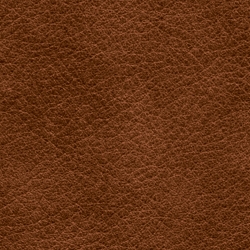
“Leather that has been dyed by immersion in a dyebath and has not received any coating of pigmented finish. A natural or dyed leather finished by application of a coherent surface coating, clear or coloured with dye”
Cons
|
Pros
|
Aniline leathers generally have no surface finish, however some anilines can be sprayed with a lacquer to make them more ‘useable’. This is just a thin coating of finish but makes an aniline easier to care for.
Identifying Aniline Leathers
The Magnifying Glass Test
Looking at an aniline leather through a magnifying glass will almost certainly clarify that the leather is aniline as what you see is unlike most other leathers. The hair follicles show up so clearly on an aniline and are not as apparent on other leathers. You will be able to see many small holes on the leather surface as shown in the below picture.
The small holes are where the hair was removed from the hide. Seeing these holes indicates that no pigmented finish has been applied - if it had, these holes would have been filled in.
The Absorption Test
Drip a small amount of leather cleaner or water on to the aniline leather. You will notice that the leather has absorbed the cleaner leaving a dark patch, which will dry out. An aniline will completely absorb the liquid in about 30 seconds. If the aniline has been finished the liquid will not be absorbed, use the magnifying glass test to identify the leather in this case.
NOTE: If the leather absorbs the water quickly, it means that it will also absorbs stains easily & quickly. It is crucial to maintain this leather with regular applications of the leather protection cream. If your leather has faded you will need the leather re-colouring balm to restore the colour.
The Touch Test
Aniline leather feels very soft and natural and will lighten if scratched, finished aniline leathers willnot lighten when scratched.
The Visual Test
The colour of an aniline will not look as uniform as that of a pigmented leather, the full grain pattern is visible and people with good eyes may see the hair follicles. Natural scarring and bites will be visible on the surface if there are any.
Pull Up Leather

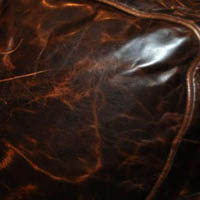
“A leather that by design lightens in colour when stretched.”
Pros
|
Cons
|
Identifying NORMAL & WAXY Pull Up Leather
The Magnifying Glass Test
Under a magnifying glass pull-up leather looks very cracked. Due to the nature of the finish the lighter colour shows through all the natural creases and cracks in the leather making them very evident when magnified. For waxy pull up leather, the hair follicles are slightly visible and are generally a darker colour where they have absorbed the oil or wax. A lighter colour will also show through the grain.
The Absorption Test
NORMAL: Drip a small amount of leather cleaner or water onto a pull-up leather and it will absorb it within about 15 seconds. As pull-up leathers are generally quite dark the water stain shows more of a matt area rather than a darker area.
WAXY: If you drip a small amount of leather cleaner or water onto the surface of an oily / waxy pull up leather it will absorb it instantly – within a matter of seconds. The leather will slightly darken and then return to normal quite quickly.
NOTE: If the leather absorbs the water quickly, it means that it will also absorbs stains easily & quickly. It is crucialto maintain this leather with regular applications of the leather protection cream. If your leather has faded you will need the leather re-colouring balm to restore the colour.
The Touch Test
A pull-up leather feels very soft and natural. When stretched it will lighten in colour. It scratches quite easily as well, again to a lighter colour.
An oily / waxy pull up feels very natural, with a slightly wax feel to it. It scratches extremely easy and changes to a lighter shade when stretched.
The Visual Test
The colour of a pull-up leather is quite uniform, however as the leather ages and the lighter colour shows through it can look quite distressed. It looks very natural as it only has a slight finish applied. If your leather has faded & scratched you will need the leather re-colouring balm to restore the colour.
Rub Off Leather
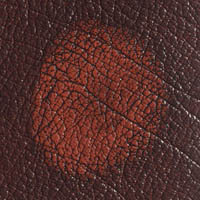
“This is a pigmented leather with a rub off finish. There are two colours visible in rub off leathers, a base colour (bright colour) and a top colour (dark colour). The way in which these leathers are made, allows the base colour to show through the dark top colour creating an antique look”
Pros
|
Cons
|
Identifying Rub Off Leather
The Magnifying Glass Test
Under a magnifying glass rub off leather has the same ‘painted’ on look as a pigmented leather. However you will notice small amounts of the brighter colour showing through the leathers grain.
The Absorption Test
Rub off behaves just like pigmented leather with the drip test. Drip a small amount of leather cleaner or water on to the leather. It will sit on the surface so dab it with a piece of cloth to absorb the liquid. You will notice that no cleaner will be absorbed by the leather.
The Touch Test
Touching a rub off leather shows the exact same characteristics of a pigmented leather. A pigmented leather feels as though it is coated, if an artificial grain pattern has been embossed you will also be able to feel this on the surface. A rub off leather will not scratch easily.
The Visual Test
This is where rub off differs from a standard pigmented leather. The colour looks old and worn – antique. You will be able to see parts of the bright colour showing through the dark top coat, which creates the antique effect. Rub off leathers often have a high gloss finish.
If you do not maintain the leather using the leather protection cream, the top coat of colour can wear off in high use areas. To make the leather last longer, apply the protection cream once every three months to reduce friction and so, stop the colour wearing away as quickly.
If the colour does wear away, you will need an Antique Finish kit to fix it.
Semi-Aniline Leather
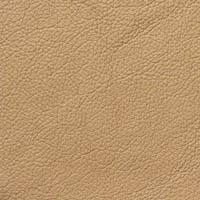
“A leather in which the base coat of the finish contains finish but later coats contain only dye, or contrasting pigment, to give a two-tone appearance, designed to imitate aniline leather”
Pros
|
Cons
|
Identifying Semi-Aniline Leathers
The Magnifying Glass Test
Looking at a semi-aniline leather through a magnifying glass will look quite similar to an aniline. The hair follicle holes are slightly visible (as indentations) but you will notice a thin pigmented coating covering them. Some semi-anilines have thicker coatings than others and so the holes may not always be identifiable.
The Absorption Test
Drip a small amount of leather cleaner or water on to the semi-aniline leather. It will sit on the surface so dab it with a piece of cloth to absorb the liquid. You will notice that the leather will absorb a very small amount of this liquid, this shows by a slightly darker patch. It can take between 3 – 4 minutes for a semi-aniline to absorb a drop of cleaner.
The Touch Test
Semi-aniline feels quite natural and soft to the touch. The finish is often smooth and you can feel the lacquered surface, which makes the leather semi slippery compared to an aniline.
The Visual Test
The colour of a semi-aniline will look quite uniform, not as varied as aniline and not as uniform as pigmented. The grain pattern will be natural looking as only a thin pigmented coating is applied. You may be able too see natural markings, but you will have to look closely to spot them. A semi-aniline is often two toned but this two tone effect can sometimes be very slight and so hard to spot.
If you do not maintain the leather using the leather protection cream, the top coat of colour can wear off in high use areas. To make the leather last longer, apply the protection cream once every three months to reduce friction and so, stop the colour wearing away as quickly.
Pigmented Leather
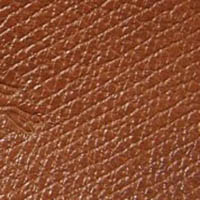
“A leather to whose grain surface a finish containing fine pigmented particles in a binder has been applied”
Pros
|
Cons
|
Identifying Pigmented Leathers
The Magnifying Glass Test
Looking at a pigmented leather through a magnifying glass will show a sound uniform coating. There will be no difference in shade or colour and if embossed the grain will also look very uniform.
The Absorption Test
Drip a small amount of leather cleaner or water on to the pigmented leather. It will sit on the surface so dab it with a piece of cloth to absorb the liquid. You will notice that no cleaner will be absorbed by the leather. Pigmented leathers are well finished and so are non absorbant.
The Touch Test
A pigmented leather feels as though it is coated, if an artificial grain pattern has been embossed you will also be able to feel this on the surface. A pigmented leather will not scratch easily.
The Visual Test
The colour of a pigmented leather is 100% uniform, there will be no alterations in colour or shade. Scarring and other visual defects should be hidden by the pigment or have been buffed away and so the coating should have a totally uniform pattern.
Finished Split
This is a similar type of leather to pigmented leather, the only difference is that in a finished split the pigment is applied to the split of the leather, whereas a standard pigmented leather has had the pigment applied to the grain. This type of leather is cheaper to produce so is commonly used on the backs and sides of upholstery.
Bi-Cast Leather
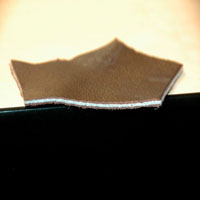
“This is either a finished split or coated leather, which has had a polyurethane film bonded to the surface”
Pros
|
Cons
|
Identifying Bi-Cast Leathers
The Magnifying Glass Test
Looking at Bi-cast through a magnifying glass will show a sound uniform coating. There will be no difference in shade or colour.
Depending upon wether the leather is a split or top grain you may or may not see hair folicles.
The Absorption Test
Drip a small amount of leather cleaner on to the Bi-cast. It will sit on the surface so dab it with a piece of cloth to absorb the liquid. You will notice that no cleaner will be absorbed by the bi-cast, this is due to the plastic film on surface.
The Touch Test
Bi-cast feels like plastic, to the touch it is smooth and quite slippery. It will not scratch easily.
The Visual Test
The colour of bi-cast is 100% uniform, there will be no alterations in colour. The same applies to the grain pattern, this will be uniform throughout the whole surface as it is artificial. Bi-cast also looks very glossy and plastic, this is a way to identify the leather as it shines a lot more than any other leather type.
The problem that can occur with bi-cast is waxes/oils/grease and things like hair spray etc can attack the plastic coating. This can make the area go dull, sticky or peel. This can be prevented with regular applications of the leather conditioning cream.
Article by furnitureclinic.co.uk



